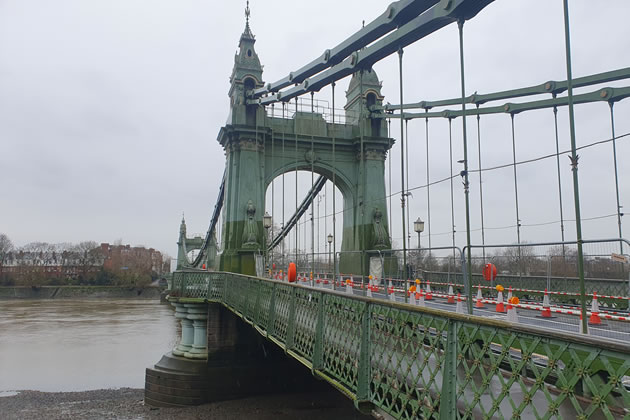Dispute Arises over Hammersmith Bridge Stabilisation Costs
Council wants TfL and the government to contribute more

Hammersmith Bridge
February 7, 2025
Hammersmith & Fulham Council has requested £20.7 million it says it is owed from the Government and Transport for London towards stabilising and restoring Hammersmith Bridge – though it’s unclear if the other two parties agree they should pay it.
The borough says says it has spent almost £48m on stabilisation and pre-restoration works since the Grade-II* listed crossing was closed in 2019. Under a 2021 funding settlement the previous Government struck with Transport for London (TfL), it was stated the local authority would pay a third of the total cost. TfL and the Department for Transport (DfT) are to pick up another third each.
However a council report says the DfT and TfL have, as of December last year, contributed £8.3m and £2.9m respectively towards the total £48m spend and the council wants to recoup some of its costs so far.
A spokesperson for the DfT said the department has actually provided £13m towards the bridge so far, but Hammersmith and Fulham’s position is that only £8.3m of this is directly related to the stabilisation and restoration costs incurred by the council. So it appears that complications around what each party has spent so far and what they should be expected to pay could hamper the council’s efforts to get the £20.7m it wants at this stage.
Both the DfT and TfL have provided non-committal responses to the Local Democracy Reporting Service (LDRS) around that £20.7m figure cited by Hammersmith and Fulham, though it’s understood the DfT has not yet received a formal request for the restitution of the costs.
A TfL spokesperson said the transport authority has been supporting Hammersmith and Fulham and will continue to work with the DfT on restoring the bridge. TfL also pointed to data indicating that while it has contributed just under £3m to stabilisation works it has additionally helped the council develop refurbishment plans. In this capacity it says it has spent £16.7m on assessments, feasibility, inspectors and surveys, designs and other associated matters.
The 138-year-old bridge connecting Hammersmith with Barnes was closed to motor vehicles in April 2019 and all users in August 2020. This was due to public safety concerns after micro-fractures were discovered in its pedestals. It has since been reopened to pedestrians, cyclists – who must dismount from their bikes – and river traffic.
The total estimated cost of repairing and reopening the bridge has risen steeply since its closure and was estimated last year at £250m, with an undetermined number of future phases of work needed to complete it. Hammersmith and Fulham, which owns the bridge, has said a toll would be required to fund its share.
It is understood the DfT’s position is that due to challenging finances, any solution to Hammersmith Bridge will require what it deems to be an appropriate sharing of costs between partners. Any further funding consideration is reliant on an agreement over engineering and cost-sharing.
The council first submitted its business case outlining plans to restore and reopen the bridge to the previous Government in December 2022, and formally in March 2023. It is still awaiting approval.
In a report prepared for next week’s (10 February) Cabinet meeting, citing the costs it says each party has paid so far, officers state, “The council is therefore due a further total of £20.7m from DfT and TfL and is requesting that the previously agreed contributions are paid up in full.”
The report also referenced the need for a toll if the council is to fund its share. It read, “Despite the relevant government minister expressing support for the council’s use of a toll or road user charging scheme to fund its contribution, support has not been forthcoming to date from TfL and/or DfT.”
A DfT spokesperson said, “The London Borough of Hammersmith and Fulham is responsible for the operational and maintenance costs of the bridge as the asset owner. We continue to work closely with the London Borough of Hammersmith and Fulham and Transport for London on exploring options for the future of the bridge and the department has provided £13m of funding towards the project so far.”
Any capital programmes such as Hammersmith Bridge are expected to be made in the context of Chancellor Rachel Reeves’s Spring Spending Review. A TfL spokesperson said, “We have been actively supporting the London Borough of Hammersmith and Fulham and we will continue to work closely alongside the Department for Transport, the borough and other stakeholders on the Hammersmith Bridge Taskforce to agree the right solution, which includes ongoing discussions on how future work on the bridge might be funded.”
A spokesperson for the council said, “We meet regularly with DfT and TfL and expect them to meet the agreed contributions.”
A Hammersmith Bridge taskforce which had not met in three years was reconvened last week by Labour’s Minister for Local Transport, Simon Lightwood.
The LDRS covered how Seb Dance, Sir Sadiq Khan’s Deputy Mayor for Transport, was said to have found the meeting ‘constructive’.
Andrew Slaughter, the Labour MP for Hammersmith and Chiswick and a member of the taskforce, wrote in local publication Chiswick W4: “At the meeting we narrowed down the options for the future of the bridge, agreed to look at cheaper ways to repair it and to get up to date figures on the impact on traffic using other roads and bridges (including Chiswick and Kew) in the area. We will meet again as soon as this information is assembled.”
Ben Lynch - Local Democracy Reporter